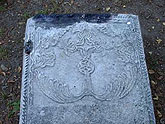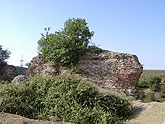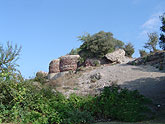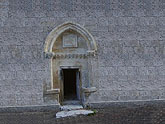|
|
|
|
|
|
|
| |
| |
Church
Chotaari in Nijh |
| |
Udins'
Cross |
| |
The
remains of vallums of the ancient Gabalah |
| |
Temple
on the mountain Komrat |
 |
Settlement
Nijh |
 |
Settlement
Nijh |
 |
Settlement
Nijh |
 |
Settlement
Nijh |
 |
Settlement
Nijh |
|
Settlement
Nijh
(Gabalah area)
HISTORY
The
settlement Nijh is located in 40 km to the South -
West from the regional center Gabalah. About 4000
representatives of the Udin ethnos live in this habitation.
The first authentic data about the Udins appeared
2.500 years ago. Herodot, the ancient Greek author
of the V-th century B.C., tells in his "History" about
ancestors of this tribe -the Uties. They are mentioned
in "Geography" by the ancient Greek writer of the
I-st century B.C. Strabon in the description of the
Caspian Sea and the Caucasian Albania. For the first
time the ethnic term udines appears in "Natural history"
by the Romanian author of the I-st century A.C. Plyniy
the senior. Various tribes including the Uds is informed
in "Geography" by the ancient Greek writer of the
II-nd century A.C. Ptolemy to live on the Caspian
sea. The Udins belong to those to 26 Albanian tribes
that are founders of the Albanian empire and relate
to a number of ancestors of modern Azerbaijan people.
The most detailed proves about the Udins are in "the
Albans' Histoy" by the local author Moisej Utijsky
who lived in the VIII-th century and belonged by its
own words to the Udins' tribe. He also informs on
the mythical ancestor of 26 Albanian tribes Aran:
"The tribes of the Utiy, Gardman, Tsavdey, Gargar
princedoms sprang from his (Aran's) son".
After the Arabian gain of Azerbaijan in the VII-th
century and inclusion of the whole country into structure
of Arabian caliphate, the overwhelming number of local
indigenous population including the Udins, e accepted
islam. But their part retained the former belief owing
to what in the VII-th century by will of the Arabian
caliphate it appeared to be included in structure
of the Armenian Gregorian church, which from the VI-th
century would undertake attempts to violently subordinate
the autocephalous Albanian church. However, even after
the VIII-th century the Albanian Catholicon and its
office were preserved, the process of active deetnization
and armenization of the Albani-Christians happened.
As a result, in a zone of Nagorny Karabakh they have
completely lost the language and culture. In a zone
of Gabalah and Oguz the Udins have managed to keep
the originality of the native language up to now (however,
unwritten), though they experienced strong influence
of the church alien to them.
The culmination in destiny of the Udins-Christians
after their transfer to a bosom of the Armenian Church
became 1836-th year, when a Saint Synod of the Russian
Orthodox Church and the Russian government decided
to liquidate a throne and a chancellery of the Albanian
Catholicos.
During centuries-old formation of Azerbaijani people,
especially after distribution of islam and Turkic
language in Azerbaijan, autochthonous tribes have
merged in uniform ethnos - the Azerbaijanians. But
the Udins-Christians were saved as a national minority
with own language, material and spiritual culture,
ethnopsychology. The Udin language entered the Caucasian
language family, and the Udins belong to ancestors
of the modern Azerbaijani people. The Udins profess
Christianity. The Udins living in the area of Oguz,
are orthodox. The Udins have kept ancient ceremonies
and customs up to now. Ceremonies of holidays represent
mixture of the Udin pagan and Christian cults. |
In
1854 first in Nijh the Udin School opened, and then
in Vartashen a rural school with teaching in Russian
became operated. Among teachers there were local residents
- the udins. For continuation of education the Udins
went to study in Moscow, Kozlov (commercial school),
Gory (theological seminary), and Tbilisi (an average
business school). In 1931-1933 years the Udins' training
was in the native language, from 1937 in Azerbaijan
- in the Azerbaijani and Russian languages, in Georgia
- in the Georgian one. They continued education preferably
in High schools and technical schools of Baku, Tbilisi,
cities of Russia. Even knowing the Armenian language,
neither in the past, nor subsequently, down to our days,
the Udins wished to receive education at schools, colleges,
technical schools or High schools of Armenia.
|